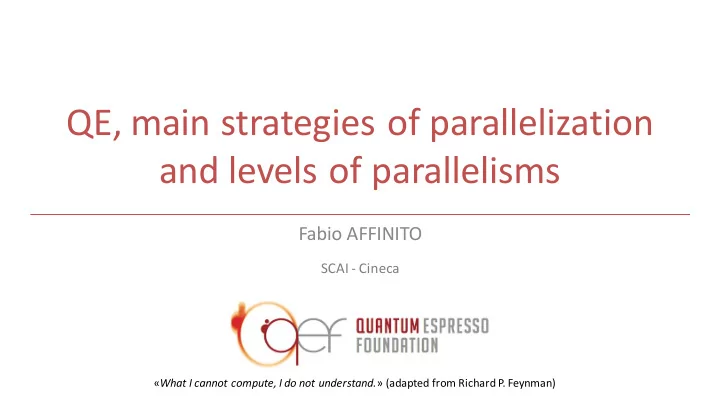

QE, main strategies of parallelization and levels of parallelisms Fabio AFFINITO SCAI - Cineca « What I cannot compute, I do not understand. » (adapted from Richard P. Feynman)
Quantum ESPRESSO: introduction • Quantum ESPRESSO is an integrated software suite for atomistic simulations based on electronic structure, using density-functional theory(DFT), a plane waves (PW) basis set and pseudopotentials (PP) • It is a collection of specific-purpose software, the largest being: – PWSCF – CP plus many other applications able to post-process the wavefunctions generated by PWscf (for example PHonon, GW, TDDFPT, etc)
PWscf • As an example, let’s watch at the structure of PWscf Linear algebra FFT
Technical infos • Quantum ESPRESSO is released under a GNU-GPL license and it is downloadable from www.quantum-espresso.org • Mostly written in Fortran90 • Ongoing effort to increase the modularization (MaX CoE funded) • It can use optimized libraries for LA and FFT (i.e. MKL, FFTW3, etc), but it can be also compiled without any external library • MPI based parallelization: multiple communicators, hierarchical strategy • OpenMP fine grained parallelization + usage of threaded libraries (OpenMP tasks will be soon implemented)
Relevant quantities • N w : number of plane waves (used in wavefunction expansion) • N g : number of G-vectors (used in charge density expansion) • N 1 , N 2 , N 3 : dimensions of the FFT grid for charge density (for Ultrasoft PPs there are two distinct grids) • N a : number of atoms in the unit cell or supercell • N e : number of electron (Kohn-Sham) states (bands) • N p : number of projectors in nonlocal PPs (sum over cell) • N k : number of k-points in the irreducible Brillouin Zone
Parallelization strategy • Goals: – Load balancing – Reduce communication – Fit the architecture (intranode/internode) – Exploit asynchronism and pipelining
Coarse grain parallelization levels Coarse grain, high level QE data distribution 1. Plane-waves (MPI_Comm_World) MPI_COMM_WORLD 2. Images 3. K-points IMAGE GROUP 0 IMAGE GROUP 1 IMAGE GROUP … 4. Bands K-point K-point K-point GROUP 0 GROUP 1 GROUP … + a finer grain data distribution Band GROUP 0 Band GROUP 1 Band GROUP … Fine grain parallelization
Fine grain parallelization levels Data can be furtherly redistributed in order to accomplish specific tasks, such as FFT or linear algebra (LA) routines
Image parallelization • A trivial parallelization can be made on images. Images are loosely coupled replica of the system and they are useful for – Nudged Elastic Band calculations – Atomic Displacement patterns for linear response calculation and in general for all the cases in which you want to replicate N times your system and perform identical simulations (ensemble techniques). mpirun – np 64 neb.x – nimage 4 – input inputfile.inp
k-point parallelization • If the simulation consists in different k-points, those can be distributed among n pools pools of CPUs • K-points are tipically independents: the amount of communications is small • When there is a large number of k-points this layer can strongly enhance the scalability • By definition, n pools must be a divisor of the total number of k-points mpirun – np 64 pw.x – npool 4 – input inputfile.inp
Band parallelization • Kohn-Sham states are split across the processors of the band group. Some calculations can be independently performed for different band indexes. • In combination with other levels of parallelism can improve performances and scalability • For example, in combination with k-points parallelization: mpirun – np 64 pw.x – npool 4 – bgrp 4 – input inputfile.inp
Linear algebra parallelization • Distribute and parallelize matrix diagonalization and matrix-matrix multiplications needed in iterative diagonalization (SCF) or orthonormalization(CP). Introduces a linear-algebra group of n diag processors as a subset of the plane-wave group. n diag = m 2 , where m is an integer such that m 2 ≤ n PW . • Should be set using the – ndiag or -n ortho command line option, e.g.: mpirun – np 64 pw.x – ndiag 25 – input inputfile.inp
Task-group parallelization • Each plane-wave group of processors is split into n task task groups of n FFT processors, with n task × n FFT = n PW ; • each task group takes care of the FFT over N e /n t states. • Used to extend scalability of FFT parallelization. • Example for 1024 processors – divided into n pool = 4 pools of n PW = 256 processors, – divided into n task = 8 tasks of n FFT = 32 processors each; – Subspace diagonalization performed on a subgroup of n diag = 144 processors : mpirun – np 1024 pw.x – npool 4 – ntg 8 – ndiag 144 – input inputfile.inp
OpenMP parallelization • Explicit with workshare directives on computationally intensive for-loops • Implicit, when using external thread-safe libraries, e.g. – MKL for linear algebra and fft (DFTI interface) – FFTW/FFTW3 • Usually scalability on threads is quite poor (no more than 8 threads). • Ongoing effort to enhance OpenMP scalability using tasking techniques – Necessary when working on many-cores architectures
Some examples • 128 water molecules, PW calculation (IBM Power6), MPI- only • When scalability saturates, using task-groups permitted to push further..
Some examples
Recommend
More recommend